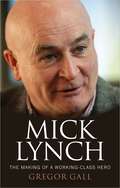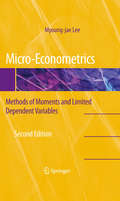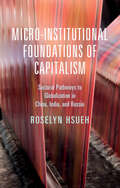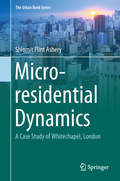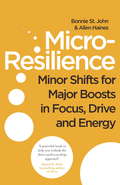- Table View
- List View
Mick Lynch: The making of a working-class hero
by Gregor GallIn the summer of 2022, the little-known leader of a small union became a ‘working-class hero’. Facing down media pundits who thought they could walk all over him, he offered a robust critique of the government and provided workers with an authentic voice. At a time when the Labour Party was unable to articulate a credible alternative to the Tories, Mick Lynch spoke for the working class. Where did Lynch come from? How did he develop the skills and traits that make him such an effective spokesperson and leader? This book, the first biography of Lynch, explores his family and social background and his rise to the top of the RMT union, which culminated in election as General Secretary in 2021. Considering his persona and politics, this book asks what quality singles out Lynch as a working-class hero compared to other union leaders and, more broadly, what leadership means for working people and for the left.If we want better leaders at every level, the case of Mick Lynch holds the key.
Micro — QUALIFLEX: An Interactive Software Package for the Determination and Analysis of the Optimal Solution to Decision Problems
by J.P. AncotMicro- and Macrodata of Firms: Statistical Analysis and International Comparison (Contributions to Statistics)
by Silvia BiffignandiIn industrial countries there is a strong interest in the international comparison of business data regarding productivity efficiency and competitiveness. This volume presents methods for the statistical analysis of micro- and macrodata of firms and for an international comparison of the aggregates. Case studies referring to specific countries play an important role for the development of economic hypotheses that should be tested at the international level.
The Micro Cap Investor: Strategies for Making Big Returns in Small Companies (Wiley Trading #212)
by Richard ImperialeThe Micro Cap Investor Learn how today's smartest investors are discovering opportunities--and reaping profits--ahead of the Wall Street pros Micro cap stocks are all but ignored by professional investors who can't risk losing their companies' clients--and their own careers--to the sudden volatility and price swings that are common to the micro cap market. But it is just that volatility, plus their proven record for outperforming large cap stocks over the long term, that makes micro caps perfect for independent investors looking for market-beating returns. The Micro Cap Investor takes a behind-the-scenes look at this exciting sector to: * Detail a market-tested process for uncovering and investing in micro caps with the greatest potential to outperform the market * Reveal the ten key catalysts that take under-the-radar micro caps and propel them into the public spotlight * Explain how smaller investors can use the "information advantage" to actually gain a sizable edge over institutional investors Let The Micro Cap Investor show you how to uncover today's most promising companies, and use the power of micro cap investing to dramatically improve your long-term investment performance.
Micro-Clusters and Networks
by Ewen MichaelThis book introduces a new approach to the analysis and management of growth in small tourism markets for regional and rural locations. It recognizes from the outset that the vast bulk of the tourism industry’s product is delivered by small business enterprises and that many of these are located outside of metropolitan areas. Its central premise is that a myriad of small-scale clusters can provide an effective means to establish a local competitive advantage in tourism activities based on the resources of existing communities. The book brings together contemporary views of the potential of clustering theory to promote development in micro-markets, within the paradigm of competition, to create a new framework for regional development that might serve to enhance the growth of small-scale tourism destinations.Microclusters and Networks provides a theoretical explanation of how and why micro-clusters come about, with chapters by specialist authors to illustrate examples of their practice in the real world; but it goes further to demonstrate not only why they work but also how community members interact to form successful clusters. The incorporation of networking theory provides the means to explain the role of local community interaction in delivering successful social outcomes. The analysis that is provided clearly has applications for many industries beyond the development of rural and regional tourism destinations.
Micro-Clusters and Networks
by Ewen MichaelThis book introduces a new approach to the analysis and management of growth in small tourism markets for regional and rural locations. It recognizes from the outset that the vast bulk of the tourism industry’s product is delivered by small business enterprises and that many of these are located outside of metropolitan areas. Its central premise is that a myriad of small-scale clusters can provide an effective means to establish a local competitive advantage in tourism activities based on the resources of existing communities. The book brings together contemporary views of the potential of clustering theory to promote development in micro-markets, within the paradigm of competition, to create a new framework for regional development that might serve to enhance the growth of small-scale tourism destinations.Microclusters and Networks provides a theoretical explanation of how and why micro-clusters come about, with chapters by specialist authors to illustrate examples of their practice in the real world; but it goes further to demonstrate not only why they work but also how community members interact to form successful clusters. The incorporation of networking theory provides the means to explain the role of local community interaction in delivering successful social outcomes. The analysis that is provided clearly has applications for many industries beyond the development of rural and regional tourism destinations.
Micro Cogeneration: Towards Decentralized Energy Systems
by Martin Pehnt Martin Cames Corinna Fischer Barbara Praetorius Lambert Schneider Katja Schumacher Jan-Peter VoßThe introduction of micro CHP – the simultaneous production of heat and power in a single building based on small energy conversion units such as Stirling and reciprocating engines or fuel cells – is of increasing political and public interest. This book introduces into micro CHP systems and technologies, and presents the results of the first such investigation carried out by four German research bodies.
Micro-Econometrics: Methods of Moments and Limited Dependent Variables
by Myoung-jae LeeUp-to-date coverage of most micro-econometric topics; first half parametric, second half semi- (non-) parametric Many empirical examples and tips in applying econometric theories to data Essential ideas and steps shown for most estimators and tests; well-suited for both applied and theoretical readers
Micro-Economics: Optimal Decision-Making by Private Firms and Public Authorities
by C. Abraham A. ThomasThe origin of this work is to be found in the cyclostyled course on 'The optimal allocation of resources in the firm and in the Nation' taught by Mr Boiteux at the Centre d'Etudes des Programmes Economiques (C. E. P. E. ), Paris from 1957 to 1960. Of course, several successive later rewritings and a great many additions have profoundly altered the initial version: starting from a remarkably clear and concise exposition of eco nomic theory, we have ended with a book that is several hundred pages long. It is not at all certain that Mr Boiteux would recognise this intellec tual sponsorship. Nor is it certain that the gain in information justifies such an increase in size. However that may be, the initial plan has survived. Without Mr Boiteux this book would never have been undertaken: it is a pleasant duty for us respectfully to acknowledge our debt to him here. Microeconomic analysis, that is to say that analysis which results from the study of the behaviour and activities of individual decision-units, was for a long time the main concern of the neo-classicists. Quite recently the introduction of macroeconomic theory, dealing with aggregate quan tities, seemed to relegate it to second place. But this is not where it belongs: we tend to agree with Mr Raymond Barre that there are "two different scales of analysis that complement rather than contrast with one another".
Micro-Entrepreneurship For Dummies
by Paul MladjenovicTired of the 9-to-5 grind and want a way to earn or to supplement your income? Easy. The media has named the growing trend toward micro-entrepreneurship "the Rise of the Creative Class," "the Gig Life," or "the freelance economy." All of those refer to the nearly 4 million workers who were self-employed this past year, and millions of others who currently supplement their income with freelance work. While the trend has been spotted before, there's one stark difference between micro-entrepreneurs today and the "Free Agent Nation" citizens of the late '90s: technology. Micro-Entrepreneurship For Dummies shows you how to navigate this confusing technological landscape in order to make a contributable profit. Micro-Entrepreneurship For Dummies aids you in making the best use of micro-entrepreneurial platforms, with helpful advice that includes information on signing up for and selling products on websites such as Airbnb, Craigslist, Taskrabbit, Uber, and Etsy. Micro-enterprise, using online platforms to sell products or services,??is a proven way to earn extra money and supplement household income In today's struggling economy, the importance of self-run businesses and small enterprise is growing as more people take lower-paying jobs and need a little extra spending money Shows you how to sign up for and sell products online Micro-Entrepreneurship For Dummies appeals to anyone looking to earn or supplement their income from home.
Micro-Entrepreneurship For Dummies
by Paul MladjenovicTired of the 9-to-5 grind and want a way to earn or to supplement your income? Easy. The media has named the growing trend toward micro-entrepreneurship "the Rise of the Creative Class," "the Gig Life," or "the freelance economy." All of those refer to the nearly 4 million workers who were self-employed this past year, and millions of others who currently supplement their income with freelance work. While the trend has been spotted before, there's one stark difference between micro-entrepreneurs today and the "Free Agent Nation" citizens of the late '90s: technology. Micro-Entrepreneurship For Dummies shows you how to navigate this confusing technological landscape in order to make a contributable profit. Micro-Entrepreneurship For Dummies aids you in making the best use of micro-entrepreneurial platforms, with helpful advice that includes information on signing up for and selling products on websites such as Airbnb, Craigslist, Taskrabbit, Uber, and Etsy. Micro-enterprise, using online platforms to sell products or services,??is a proven way to earn extra money and supplement household income In today's struggling economy, the importance of self-run businesses and small enterprise is growing as more people take lower-paying jobs and need a little extra spending money Shows you how to sign up for and sell products online Micro-Entrepreneurship For Dummies appeals to anyone looking to earn or supplement their income from home.
Micro-institutional Foundations of Capitalism: Sectoral Pathways To Globalization In China, India, And Russia
by Roselyn HsuehMicro Irrigation Systems in India: Emergence, Status and Impacts (India Studies in Business and Economics #0)
by P. K. Viswanathan M. Dinesh Kumar A. NarayanamoorthyThis book takes stock of micro irrigation systems (MIS), the technological intervention in India’s agricultural and water management sectors, over the past couple of decades. Based on empirical research from the major agriculturally dynamic states, viz., Gujarat, Rajasthan, Maharashtra, Tamil Nadu, Andhra Pradesh and Karnataka, the book provides a nuanced understanding and objective assessment of the implementation and adoption of MIS across these states. It addresses several of the questions related to adoption and impacts of MIS in India. On the adoption side, the key question that the book addresses is which segment of the farming community adopts MIS across states? The impacts analysed include those on physical, agronomic and economic aspects. At the macro level, the question being asked is about the future potential of MIS in terms of saving water from agriculture and making more water available for environment. The book also addresses the question of the positive/negative externalities and real social benefits and costs from the use of MIS, a major justification for heavy capital subsidies for its purchase by farmers. It also brings out certain critical concerns pertaining to MIS adoption, which need to be addressed through more empirical research based on longitudinal panel/ cross sectional data. The book would be of great use to researchers (agricultural water management, irrigation economics), students of water resource engineering, irrigation engineering and water resources management, as well as to policy makers and agricultural water management experts – national and international.
A Micro-level Perspective On The Dynamics Of Conflict, Violence, And Development
by Patricia Justino Tilman Brück Philip VerwimpThis volume presents an innovative new analytical framework for understanding the dynamics of violent conflict and its impact on people and communities living in contexts of violence. Bringing together the findings of MICROCON, an influential five year research programme funded by the European Commission, this book provides readers with the most current and comprehensive evidence available on violent conflict from a micro-level perspective. MICROCON was the largest programme on conflict analysis in Europe from 2007-2011, and its policy outreach has helped to influence EU development policy, and supported policy capacity in many conflict-affected countries. Whilst traditional studies into conflict have been through an international /regional lens with the state as the primary unit of analysis, the micro-level perspective offered by this volume places the individuals, households, groups and communities affected by conflict at the centre of analysis. Studying how people behave in groups and communities; and how they interact with the formal and informal institutions that manage local tensions, is crucial to understanding the conflict cycle. These micro-foundations therefore provide a more in-depth analysis of the causes and consequences of violent conflict. By challenging the ways we think about conflict, this book bridges the gap in evidence, allowing for more specific and accurate policy interventions for conflict resolution and development processes to help reduce poverty in the lives of those affected by conflict. This volume is divided into four parts. Part I introduces the conceptual framework of MICROCON. Part II focuses on individual and group motivations in conflict processes. Part III highlights the micro-level consequences of violent conflict. The final section of this volume focuses on policy implications and future research agenda.
Micro Markets: A Market Structure Approach to Microeconomic Analysis (Wiley Finance #515)
by Robert A. SchwartzA timely guide that bridges the gap between microeconomic theory and practice through real-world application in the marketplace Understanding how microeconomics affects the marketplace is essential for any investment professional, however most books simply address microeconomics in its pure theory-based form. Micro Markets helps bridge the gap between theory and practice by defining microeconomics in terms of real-world, market applications. This timely guide elucidates basic microeconomic concepts with an emphasis on applicability. It establishes a common application for all of the basic economic concepts that are reviewed, and provides in-depth insights into an industry that is of major economic importance in aggregate, and to most individuals. Utilizes equity market realities to underscore the relevance of economic theory Each chapter includes informative practice problems and power points A companion Workbook, with practice problems and solutions, is also available By taking microeconomic theory and making it applicable to today's marketplace, Micro Markets builds a much-needed bridge between theory and practice.
Micro Markets: A Market Structure Approach to Microeconomic Analysis (Wiley Finance #515)
by Robert A. SchwartzA timely guide that bridges the gap between microeconomic theory and practice through real-world application in the marketplace Understanding how microeconomics affects the marketplace is essential for any investment professional, however most books simply address microeconomics in its pure theory-based form. Micro Markets helps bridge the gap between theory and practice by defining microeconomics in terms of real-world, market applications. This timely guide elucidates basic microeconomic concepts with an emphasis on applicability. It establishes a common application for all of the basic economic concepts that are reviewed, and provides in-depth insights into an industry that is of major economic importance in aggregate, and to most individuals. Utilizes equity market realities to underscore the relevance of economic theory Each chapter includes informative practice problems and power points A companion Workbook, with practice problems and solutions, is also available By taking microeconomic theory and making it applicable to today's marketplace, Micro Markets builds a much-needed bridge between theory and practice.
Micro Markets Workbook: A Market Structure Approach to Microeconomic Analysis (Wiley Finance)
by Robert A. Schwartz Michael G. Carew Tatiana MaksimenkoA companion Workbook to the text Micro Markets Understanding how microeconomics affects the marketplace is essential for any investment professional, however most books simply address microeconomics in its pure theory-based form. Micro Markets helped bridge the gap between theory and practice by defining microeconomics in terms of real-world, market applications. Now, the Micro Markets Workbook offers you a chance to review the information found in the actual book and solidify your understanding of this discipline. In this study guide, microeconomic concepts are fully reviewed, along with how all of its relevant theory is applicable to today's markets. Helps you learn to perform dynamic microeconomic analysis in practice Tests your knowledge of the information addressed in Micro Markets, before you put it to work in real world situations Provides solutions to each chapter of the main book's practice problems If you want to gain a firm understanding of the information outlined in Micro Markets, the lessons within this Workbook can help you achieve this goal.
Micro Markets Workbook: A Market Structure Approach to Microeconomic Analysis (Wiley Finance)
by Robert A. Schwartz Michael G. Carew Tatiana MaksimenkoA companion Workbook to the text Micro Markets Understanding how microeconomics affects the marketplace is essential for any investment professional, however most books simply address microeconomics in its pure theory-based form. Micro Markets helped bridge the gap between theory and practice by defining microeconomics in terms of real-world, market applications. Now, the Micro Markets Workbook offers you a chance to review the information found in the actual book and solidify your understanding of this discipline. In this study guide, microeconomic concepts are fully reviewed, along with how all of its relevant theory is applicable to today's markets. Helps you learn to perform dynamic microeconomic analysis in practice Tests your knowledge of the information addressed in Micro Markets, before you put it to work in real world situations Provides solutions to each chapter of the main book's practice problems If you want to gain a firm understanding of the information outlined in Micro Markets, the lessons within this Workbook can help you achieve this goal.
Micro-Performance During Postwar Japan’s High-Growth Era (Monograph Series of the Socio-Economic History Society, Japan)
by Haruhito TakedaThe aim of this book is to analyze Japan's high-growth economy, in particular to clarify the kinds of changes in people’s lives that were generated by high growth. The present volume focuses not on the macro-economic mechanisms that expanded the scale of the economy, but on the micro-economic changes that were effected in everyday life. The emergence of a mass consumption society as a result of economic growth suggests that people's lifestyles and consumer behavior changed in various ways. The first chapter focuses on the apparel industry's expanding market as it corresponded to changes in consumer behavior. Even as consumer life became more comfortable and abundant, consumers were becoming uneasy about the environmental deterioration associated with high growth. The second chapter examines how the Japanese government addressed emissions regulations while drawing on the lessons of America's experience with the same issue.The change in industrial structure brought about by economic growth inevitably resulted in the decline of other industries. Chief among these was the coal-mining industry, which, with the onset of a full-scale energy revolution, lost its role as energy supplier owing to the import of cheap crude oil. The third chapter discusses the government's industrial policies as they addressed the coal industry's adjustment in the high-growth era, concluding that they reduced such problems as stagnation, unemployment, and local industrial decline. The adjustments in employment practices contributed positively to the gradual shift of labor from declining industries to growth industries. The fourth chapter investigates changes in labor management in the steel industry, which was one of the high-growth era's leading industries. This publication will serve as a valuable resource for those who are interested not only in the post-war history in Japan but also in high growth economies in recent East Asia.
The Micro-politics of Microcredit: Gender and Neoliberal Development in Bangladesh (ASAA Women in Asia Series)
by Mohammad Jasim UddinMicrocredit has been seen in recent decades as having great potential for aiding development in poor developing countries, with Bangladesh being one of the countries which has pioneered microcredit and implemented it most widely. This book, based on extensive original research, explores how microcredit works in practice, and assesses its effectiveness. It discusses how microcredit, usually channelled through women, is often passed to the men of the family, a practice disapproved of by some, but regarded as acceptable by borrowers who have a communal approach to debt, rather than viewing debt as something held by single individuals. The book demonstrates how the rules around microcredit are often seem as irksome by the borrowers, how lenders often charge high rates of interest and work primarily to preserve their institutions, thereby going against the spirit of the microcredit movement, and how borrowers often end up on a downward spiral, deeper and deeper in debt. Overall, the book argues that although microcredit does much good, it also has many drawbacks.
The Micro-politics of Microcredit: Gender and Neoliberal Development in Bangladesh (ASAA Women in Asia Series)
by Mohammad Jasim UddinMicrocredit has been seen in recent decades as having great potential for aiding development in poor developing countries, with Bangladesh being one of the countries which has pioneered microcredit and implemented it most widely. This book, based on extensive original research, explores how microcredit works in practice, and assesses its effectiveness. It discusses how microcredit, usually channelled through women, is often passed to the men of the family, a practice disapproved of by some, but regarded as acceptable by borrowers who have a communal approach to debt, rather than viewing debt as something held by single individuals. The book demonstrates how the rules around microcredit are often seem as irksome by the borrowers, how lenders often charge high rates of interest and work primarily to preserve their institutions, thereby going against the spirit of the microcredit movement, and how borrowers often end up on a downward spiral, deeper and deeper in debt. Overall, the book argues that although microcredit does much good, it also has many drawbacks.
Micro-Projects: Six Exercises for Developing Project and Team Skills
by Ian StokesA project is more than an assembly of methods, tools and resources. Projects often seem to have a soul. They require dedication, belief and commitment. The only way to gain experience of a project, assess and develop the skills associated with it is to live through it. The six micro-projects in this collection highlight the kinds of skills typical of creative project teams. They can be used to practise: ¢ team working in a project environment ¢ working as a team to satisfy a need expressed in terms of time, cost and quality ¢ the skills associated with creativity, problem solving and team leadership ¢ the guiding principles for tackling projects creatively. The collection includes the following games: Eggbox is a creative project that emphasizes idea generation; Ironbridge simulates a scenario in which consortia explore the specifications of a construction project; Tower of Straws produces a situation in which change is frequent and normal; Domino Race is based on an imaginative design project that needs to reflect operational constraints; Catapult is an all-day task offering a complete project management experience and, finally, the Autonomous Team Activity encourages productivity and initiative in the project team.
Micro-residential Dynamics: A Case Study Of Whitechapel, London (The Urban Book Series)
by Shlomit Flint AsheryThis book examines how non-economic inter- and intra-group relationships were reflected in residential patterns around the first decade of the 21st century in Whitechapel, an old yet attractive absorption neighbourhood in east London, UK. It sheds light on different levels of organisation that shape urban space and suggests an integrated understanding linking socio-cultural-religious norms and the urban environment that could be extrapolated to other cities. It studies core methodologies through joining of detailed, primary empirical research, collected through direct engagement with the communities of interest, with a wider theoretical and modelling framework. This study identifies the main engines of organised neighbourhood change and the difficulties of planning. It deals with individuals in the housing market and sheds light on similar processes occurring in other city centres with diverse population groups.Based on residential records at the resolution of single family and apartment covering a period of 17 years, the study reveals and analyses powerful mechanisms of residential relations at the apartment, building and the near neighbourhood level. Taken together, these revealed mechanisms are candidates for explaining the dynamics of residential segregation in the area during the period 1995 to 2012. Whitechapel's communities are extremely diverse, composed of 27 ethnic and religious groups and sub-groups. The residential preferences of group members are highly affected by the need to live among "friends" – other members of the same group. How is it that the area has been so attractive for so many people to live in, whilst at the same time being so diverse that people cannot achieve their stated preferences to live amongst 'friends'?
Micro-Resilience: Minor Shifts for Major Boosts in Focus, Drive and Energy
by Bonnie St. John Allen P. Haines'Micro-Resilience is a powerful book that will help you rethink the drive-until-you-drop approach to work. By re-framing your thinking, you can learn to learn bounce back from setbacks and create a life of power and meaning' Daniel Pink, author of Drive and To Sell is HumanAs leadership consultants and executive trainers, Bonnie St. John and Allen Haines have heard the same complaints from clients for years; periodic burnout, lack of focus and low energy. So they dug into the latest research on neuroscience, psychology and physiology looking for big answers. Instead they found small answers; proof that small adjustments in daily routines, including thought patterns, food and drink, rest and movement can fight the forces that sap our energy and store focus and drive. They call these amazing efficient restorative techniques 'micro-resilience.'Thousands of men and women from all walks of life have already found effortless ways to incorporate these little changes into the busiest of schedules. Dozens of entertaining anecdotes from real people using micro-resilience demonstrate that when our brains fire faster, our energy increases and we can cope with almost any surprise, pressure or crisis, no matter how big or small.
Micro, Small, and Medium Enterprise Insolvency: A Modular Approach
by Riz Mokal Ronald Davis Alberto Mazzoni Irit Mevorach Madam Justice Romaine Janis Sarra Ignacio Tirado Stephan MadausThis new book systematically examines the current process for distressed Micro, Small and Medium Enterprises (MSMEs), and proposes a different, more appropriate, 'modular' approach to the treatment of such entities when faced with insolvency proceedings. MSMEs play a vital role in virtually all global economies. They are a primary means by which entrepreneurs bring new business propositions to the market, and deliver a range of products and services to local economies. MSMEs tend to be more reliant on favourable legal and regulatory climates to survive and thrive than larger businesses, and insolvency regimes are often more tailored to these larger businesses, assuming an extensive insolvency estate of significant worth, and the presence of creditors and other concerned stakeholders to participate in and oversee the process. These assumptions and features are generally incongruous with the reality of MSMEs, for whom assets are of less value and whose stakeholders are generally more disinterested. The modular approach proposed in this book addresses the imbalances, inconsistencies, and lack of supervision which is often apparent in treatment of insolvent MSMEs. It provides an overview of existing approaches to MSME insolvency, the place of MSMEs in the global economy, and the particular needs of MSMEs in financial distress. It then sets out the procedural framework, policy objectives, and key components of the modular approach, detailing how a choice of modules enables national policy-makers a more flexible process for resolution. It then outlines the roles, positions, and obligations of key stakeholder groups, and explains the managerial, administrative, and judicial functions of this approach. Finally, it explains how elements of the broader legal system should be aligned with, and supportive of, the optimal functioning of the modular approach.
